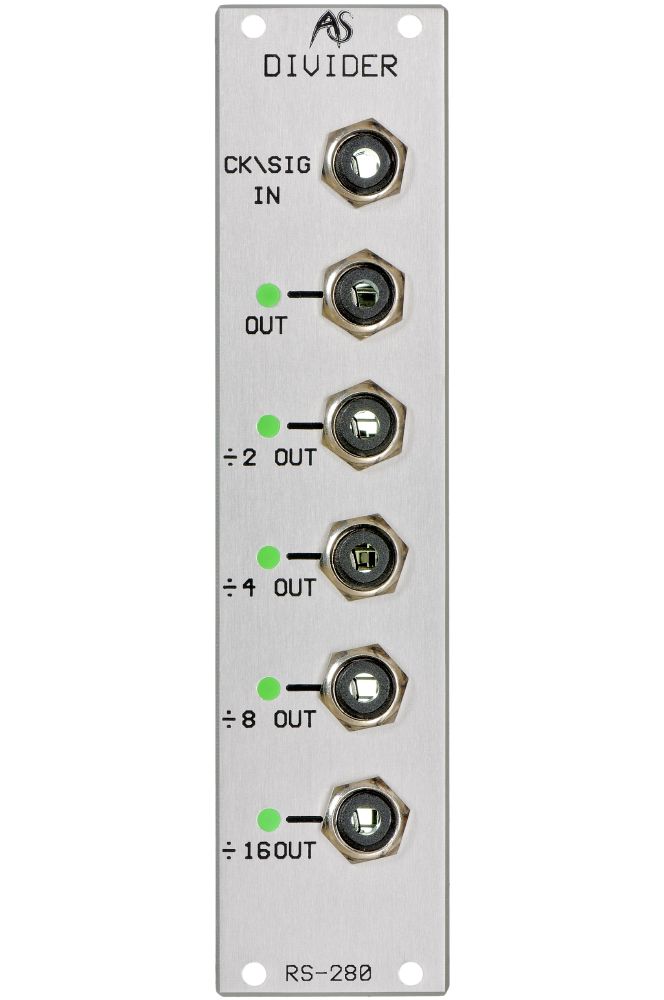Analogue Systems
RS-280
Divider
Audio and trigger clock divider.
As we've discussed elsewhere in this manual, the majority of raw signals produced by the RS Integrator are cyclic: that is, whatever shape the waveform takes, it nevertheless repeats in a regular fashion. (The common exceptions to this are the envelopes produced by the envelope generators, one-shot triggers such as those produced by the RS-40, and noise.)
If cyclic waveforms repeat rapidly (specifically, in the range 20Hz to 20kHz) we call them audio waveforms. If they repeat more slowly, we call them low frequency oscillations, or subsonic frequencies or, in special cases, clocks. But it doesn't matter what the waveform looks like - it can be a sinewave, a very narrow pulse, or a complex 'wiggly' shape - the only thing that matters in this context is that it repeats itself in a constant and definable manner.
There are many occasions when you might want to take such a waveform and extract the frequency information from it. Once you have done this, it is often useful to reduce the frequency of the resulting signal in musically meaningful ways. You might think that this is quite an unusual function, but it's one that you will find on most basic synthesisers, not just powerful modular instruments like the RS Integrator. The difference is, it hides behind a simple name: a "sub-oscillator".
This name gives you a clue to an obvious but powerful use for the RS-280: you can use it to produce square wave sub-oscillations one octave, two octaves, or even further below the source signal. You can even produce low frequency modulations that have an octave relationship with the audible signal. (You can use the SLEW controls on other modules to convert the RS-280's square waves to other, more musical, modulation waveforms.)
But useful as a multi-octave sub-oscillator is, it isn't the only use for a " frequency divider". There are many occasions when it is useful to produce related streams of clock or trigger pulses. These can then be used to trigger sounds, effects, or sequence steps in complex and musically meaningful ways. The are myriad uses for this. For example, an RS-280 coupled with an analogue sequencer such as the Analogue Systems TH48 will allow you to trigger different sequences at different rates, thus making many harmonic and polyrhythmic effects possible.
In use :
The RS-280 is a frequency detector and divider that produces a number of squarewave signals derived from the frequency of any cyclic signal presented to its input. It has a single input, five outputs, and five LEDs that give a visual indication of the frequencies of the outputs.
CK/SIG IN
This input accepts any signal in the range ±10v. These signals may be audio signals or CVs, and may be generated within the RS Integrator or presented by outside sources. If an external signal amplitude is too low for effective use as a clock or signal source, you should use the RS70 pre-amplifier to boost it to an appropriate level.
OUT
This outputs a squarewave with voltages 0v and +10v, suitable for use as a trigger or clock. The frequency of the output is the same as the frequency of the signal presented to CK/SIG IN.
If the input signal is at audio frequencies, the output will be an audio signal with a +5v offset. You can use the RS50's DC LEVEL SHIFTER to convert this into the range ±5v.
÷2 OUT
This outputs a squarewave with voltages 0v and +10v, suitable for use as a trigger or clock. The frequency of the output is exactly one half that of the signal presented to CK/SIG IN. If the input signal is at audio frequencies, the output will be an audio signal exactly one octave below the input. Again, this will exhibit a +5v offset, and should be SHIFTED if you wish to use it as a ±5v audio signal.
÷4 OUT
This outputs a squarewave with voltages 0v and +10v, suitable for use as a trigger or clock. The frequency of the output is exactly one quarter of that of the signal presented to CK/SIG IN. If the input signal is at audio frequencies, the output will be an audio signal exactly two octaves below the input. Again, this will exhibit a +5v offset, and should be SHIFTED if you wish to use it as a ±5v audio signal.
÷8 OUT
This outputs a squarewave with voltages 0v and +10v, suitable for use as a trigger or clock. The frequency of the output is exactly one eighth that of the signal presented to CK/SIG IN. If the input signal is at audio frequencies, the output will be an audio signal exactly three octaves below the input. Again, this will exhibit a +5v offset, and should be SHIFTED if you wish to use it as a ±5v audio signal.
÷16 OUT
This outputs a squarewave with voltages 0v and +10v, suitable for use as a trigger or clock. The frequency of the output is exactly one sixteenth that of the signal presented to CK/SIG IN.
If the input signal is at mid- to high- audio frequencies, the output will be an audio signal exactly four octaves below the input. Again, this will exhibit a +5v offset, and should be SHIFTED if you wish to use it as a ±5v audio signal. Often, the output will be subsonic, whereupon it can be used as an LFO.
LEDs
The five LEDs give a visual indication of the frequencies being produced at each of the five outputs. Because your eye cannot resolve flickering at frequencies greater than around 20Hz, LEDs that appear to be permanently lit indicate outputs at audio frequencies.
